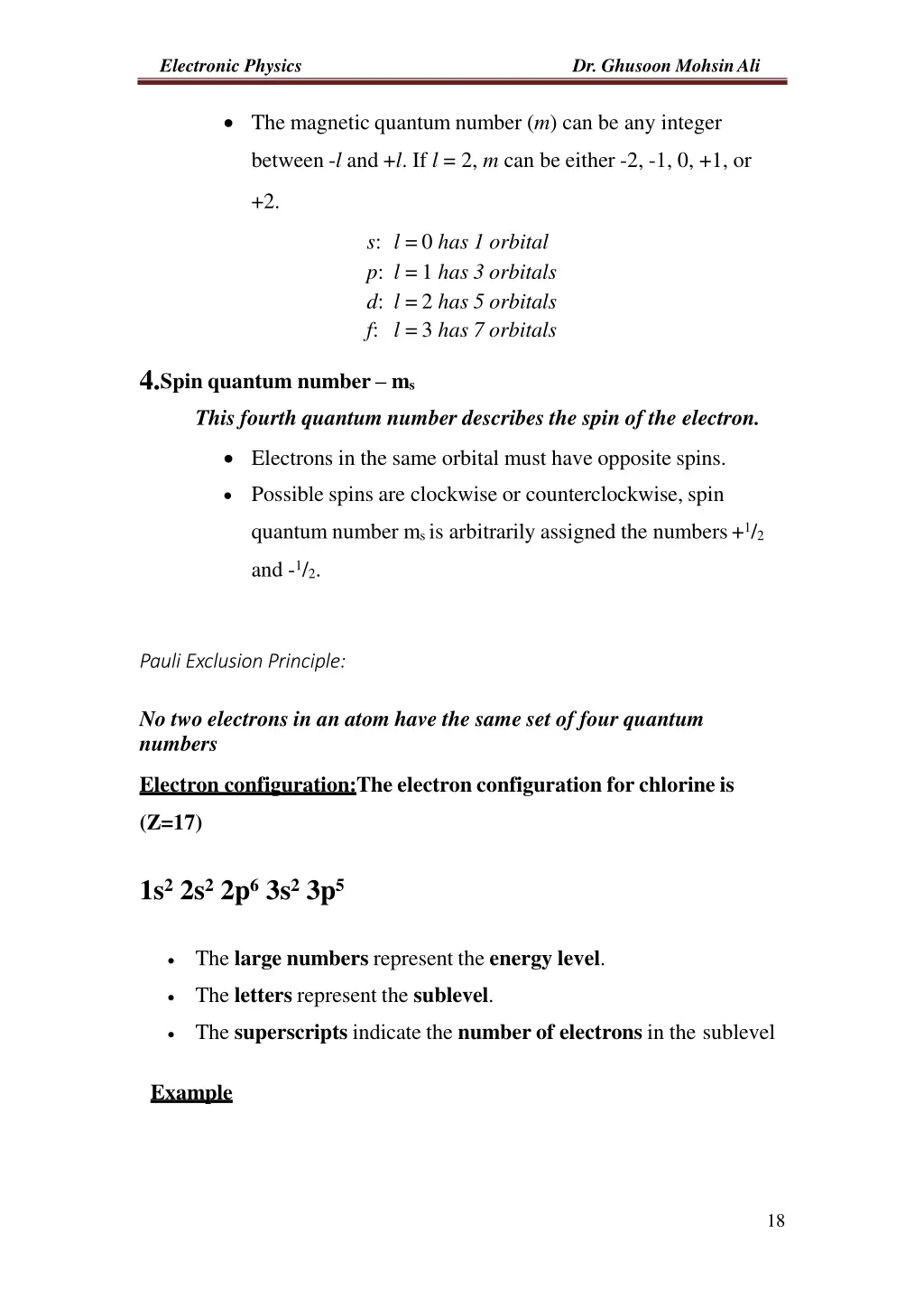
Quantum Numbers and Electron Configuration in Electronic Physics
Explore the fundamentals of quantum numbers, electron configuration, and interatomic forces in electronic physics with insights on orbital filling, spin quantum numbers, and the energy-band theory of crystals. Understand the significance of valence electrons, Pauli Exclusion Principle, and stable electron structures in atoms through examples of elements like chlorine and potassium.
Download Presentation

Please find below an Image/Link to download the presentation.
The content on the website is provided AS IS for your information and personal use only. It may not be sold, licensed, or shared on other websites without obtaining consent from the author. If you encounter any issues during the download, it is possible that the publisher has removed the file from their server.
You are allowed to download the files provided on this website for personal or commercial use, subject to the condition that they are used lawfully. All files are the property of their respective owners.
The content on the website is provided AS IS for your information and personal use only. It may not be sold, licensed, or shared on other websites without obtaining consent from the author.
E N D
Presentation Transcript
Electronic Physics Dr. Ghusoon MohsinAli The magnetic quantum number (m) can be any integer between -l and +l. If l = 2, m can be either -2, -1, 0, +1, or +2. s: l =0 has 1 orbital p: l =1 has 3 orbitals d: l =2 has 5 orbitals f: l =3 has 7 orbitals 4.Spin quantum number ms This fourth quantum number describes the spin of the electron. Electrons in the same orbital must have opposite spins. Possible spins are clockwise or counterclockwise, spin quantum number ms is arbitrarily assigned the numbers+1/2 and -1/2. Pauli Exclusion Principle: No two electrons in an atom have the same set of four quantum numbers Electron configuration:The electron configuration for chlorine is (Z=17) 1s22s22p63s23p5 The large numbers represent the energy level. The letters represent the sublevel. The superscripts indicate the number of electrons in the sublevel Example 18
Electronic Physics Dr. Ghusoon MohsinAli 1s2 2s2 2p5 means "2 electrons in the 1s subshell, 2 electrons in the 2s subshell, and 5 electrons in the 2p subshell" Fig. 1.4. The sequence of orbital filling is, from the bottom of this diagram, upwards. The electrons in the outermost orbital are known as valence electrons and determine the physical and chemical properties of the elements. An arrangement of element in term of their valence electrons forms the basis 19
Electronic Physics Dr. Ghusoon Mohsin Ali oftheperiodictable.Elementsin thegroups toV havefromonetoseven valence electrons respectively. Interatomic forces are caused by electrons in outer shell (valence shell). Atoms with 8 electrons in their outer shell ( completely filled s and p sub shell they are very stable. Most other elements attempt to reach this stable structure by one of three mechanics: 1Losing electrons:-potassium (Z=19) 1s2 2s2 2p6 3s2 3p6 4s1 losing 4s electron leaving the potassium ion with stable structure. 2Gaining electrons:-chlorin (Z=17) 1s2 2s2 2p6 3s2 3p5 can have a stable filled shell if they receive one electron. 3Sharing electrons:-silicon 1s2 2s2 2p6 3s2 3p2 share 4 electrons with 4 other silicon atoms each of which also shares silicon atom. There are three very important ways in which binding energy provided to form a stable structure. These are ionic bond, covalent bond, metallic bond. Table 1.2. Relationship among values of n, l and ml 20
Electronic Physics Dr. Ghusoon Mohsin Ali The Energy-bandTheoryof Crystals Most metals and semiconductors are crystalline in structure.A crystal consists of a space array of atoms or molecules (ions) built up by regular repetition in three dimensions of some fundamental structural unit. The electronic energy levels discussed for a single atom do not apply to the sameatominacrystal.Whenatomsformcrystalsitisfoundthattheenergy levels of the inner-shell electrons are not affected appreciably by the presence of the neighboring atoms. However, the level of the outer- shell electrons is changed considerably, since these electrons are shared bymore than one atom in a crystal. For example consider a crystal of Si consist of N atoms. If the atoms are so far apart that the interaction between them negligible. The outer two subshell of Si contain two s electrons and two p electrons.Thereare2Nelectrons completelyfillingthe2N possible s level. Since the p atomic sub shell has six possible states with 2N electrons. Because the coupling between atoms, the crystal becomes an electronic system which must obey the Pauli exclusion principle. The separation between level are small, but since N is very large (5 1022cm-3), this large number of discrete but closely spaced energy levels called energy band. The 2N states of s band are completely filled with 2N electrons, the p band of 6N states which only 2N of its levels has occupied by electrons. Note that there is an energy gap between two bands and this gap decrease as the atomic spacing decreases. These bands will overlap for small enough distance. The 6N upper states merge with the 2N lower states, giving total of 8N levels, half of which are occupied by the available electrons. At this spacing each atom has given up four electrons to the band, these electrons can no longer be said to orbit in s or p subshell of an isolated atom, but rather they belong to the crystal as a whole. At the crystal lattice spacing, we find the valance band filledwith 4N electronsseparatedby a forbidden 21
Electronic Physics Dr. Ghusoon Mohsin Ali band (Eg) from an empty band consisting of 4N additional states. This upper vacant band is called the conduction band. (a) Vacuumlevel E0 Electronaffinity Conductionband Ec Energy gap Eg Ev Valenceband Electron (b) Fig.1.5. Formation of energy bands for electrons in a silicon crystal with a diamond-type lattice structure 22
Electronic Physics Dr. Ghusoon Mohsin Ali The most electrical properties of importance to engineers are related to the upper two bands of energy levels called the conduction band and valence band. The valence band contains energies of the same level as those of valence electrons. The conduction band energies are the empty levels above the valence band. Electrons in the valence band can leave their band to join conduction band if given sufficient energy to jump the forbidden energy band gap (Eg). The size of Eg is a prime factor to determining a solid is conductor, an insulator or semiconductor. Fig. 1.6. The size of Eg to determine a solid is conductor, an insulator or semiconductor Conductors contain a large number of electrons in the conduction band at room temperature. No energy gap exist and the valence and conduction band overlap. An insulator is a material in which the energy gap is so large that practically no electron can be given enough energy to jump this gap. A semiconductor is a solid with an energy gap small enough for electrons to cross from valence band to conduction band at room temperature Silicon (Eg=1.1eV), Germanium (Eg=0.7eV) 23
Electronic Physics Dr. Ghusoon Mohsin Ali Problems Q1: Calculate the radius r of orbit and velocity of an electron with total energy of -3.4 eV in hydrogen atom. (Ans:- 2.1164 , 1.0936 106 m/s) Q2: Write all quantum number for the final electron for potassium Z=19 and chlorine Z=17. Q3: An electron drop from n=2 to ground statecalculate The energy of emittedradiation The radius when n=2 Compare between the wavelength of an electron exist in a stable orbit n=1 and the wavelength of dust particle of mass 1 10-6kg and velocity 1ms-1 (Ans:- 10.19eV, 0.212nm, 1.05 10-10m,6.626 10-29m) Q4: Calculate the energy momentum and de Broglie wave length of electron accelerated from rest by 200V. (Ans:3.2 10-17J, 7.639 10- 24kg.m.s-1,0.867 10-10m) Q5: An electron drops from specific energy level to ground state (n=1) in hydrogen atom. The energy difference between these two levels is 12.75 eV. Calculate the initial state of the electron and of the emitted radiation. (Ans: ni = 4, 972.54 ) 24






















